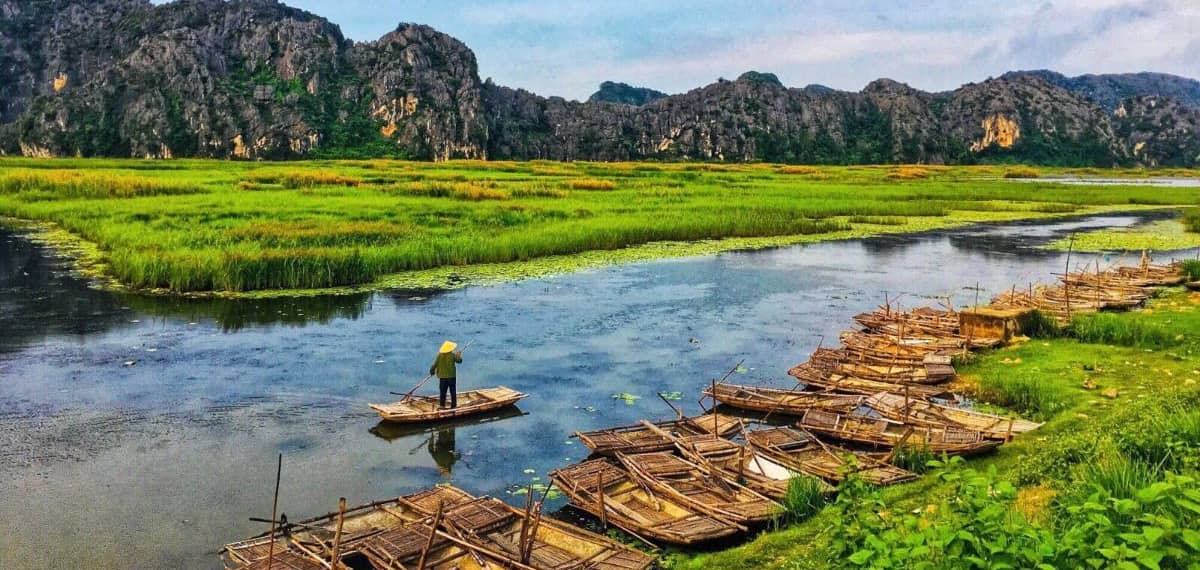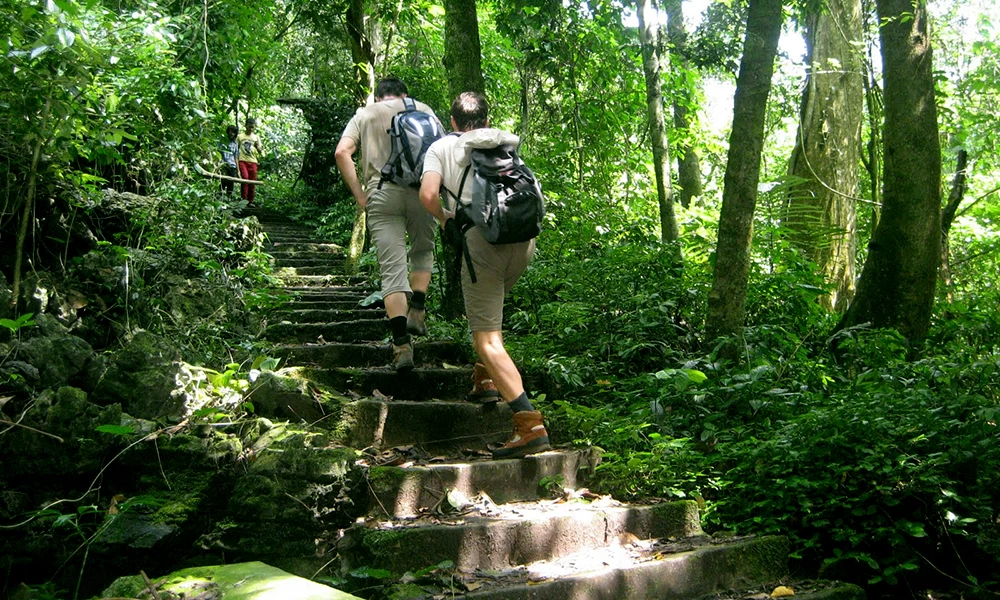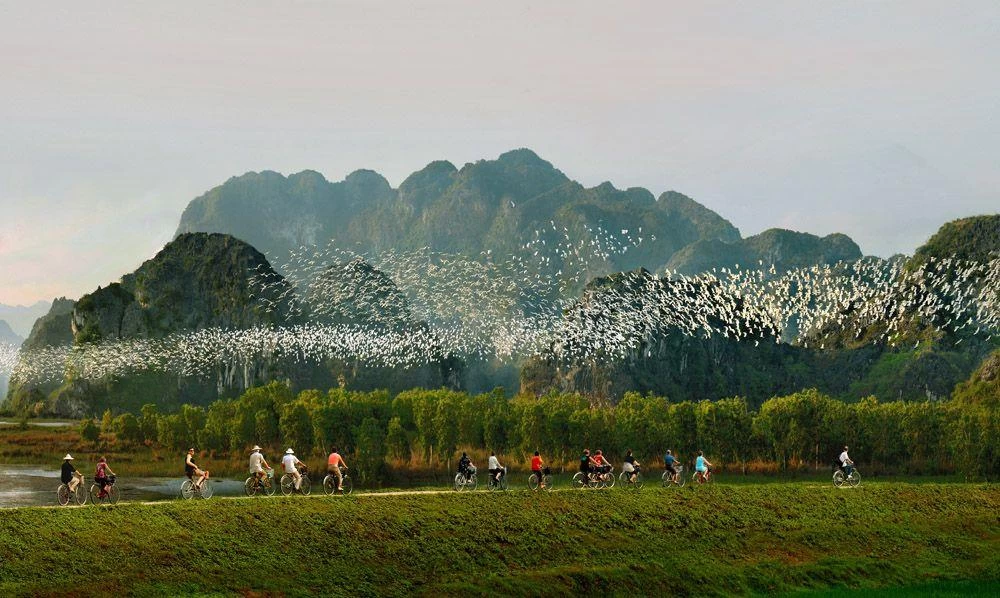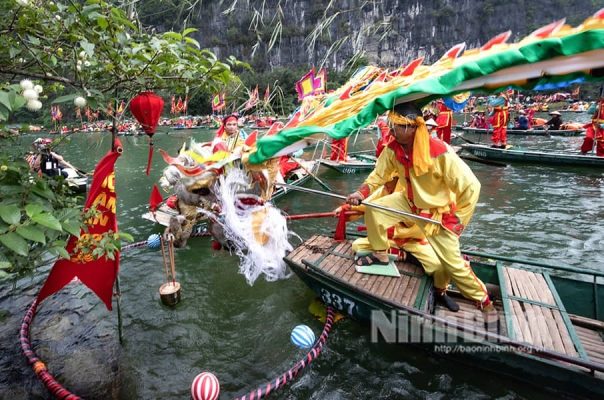
Visit Ninh Binh during the special festival season!
The festivals in Ninh Binh attract visitors not only for their sacred and nostalgic atmosphere but also for offering a chance to explore the rich culture through activities that honor history, spirituality, and the community’s values. Whether you are a cultural enthusiast, seeking tranquility, or simply want to immerse yourself in the vibrant festival atmosphere, Ninh Binh promises unforgettable experiences during every festival season. Follow Ula Travel now!
I. Introduction to Ninh Binh
1. Overview of Ninh Binh
Known as the “Inland Ha Long Bay,” Ninh Binh is a renowned destination in Northern Vietnam that offers a harmonious blend of breathtaking natural landscapes, rich culture, and profound history. Located approximately 90 kilometers south of Hanoi, Ninh Binh is famous for its UNESCO-listed sites such as the Trang An Scenic Landscape Complex, Tam Coc–Bich Dong, and the Hoa Lu Ancient Capital. This region not only boasts stunning sceneries but also preserves invaluable historical legacies from the Dinh and Early Le Dynasties, marking the early foundation of Vietnam.
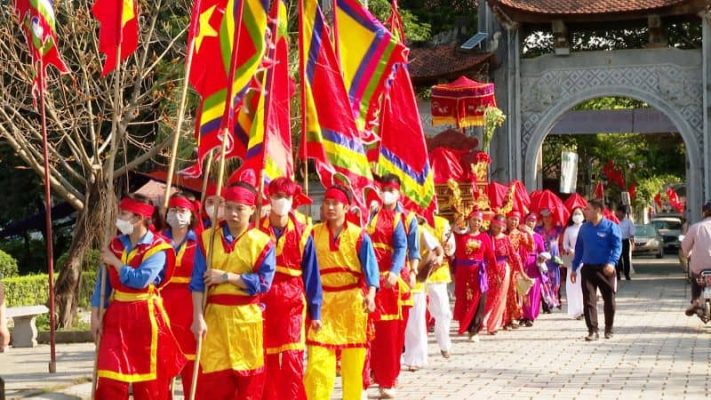
Ninh Binh is famous for its traditional festivals honoring national values.
With its unique limestone karst formations, winding rivers, and diverse ecosystems, Ninh Binh provides an unforgettable experience for international travelers. Beyond its natural beauty, the province is also known for its vibrant traditional festivals, inviting visitors to embark on a journey of deep cultural exploration.
2. Significance of Festivals in Ninh Binh
Festivals in Ninh Binh are not merely cultural events; they are bridges connecting the past to the present, linking people to nature and the divine. For local residents, these festivals are occasions to express gratitude to ancestors, honor the contributions of kings and national heroes, and pray for peace and prosperity in the coming year.
For international visitors, Ninh Binh’s festivals provide a rare opportunity to delve deeper into the culture, beliefs, and way of life of the Vietnamese people. Traditional rituals, folk performances, and the lively atmosphere of these festivals paint a vivid picture of the spiritual life of the locals.
Festivals also play a crucial role in preserving and promoting national cultural values to the world. Combining elements of religion, spirituality, and art, festivals in Ninh Binh serve as an open invitation for tourists to step into a sacred space where history, culture, and nature intertwine.
II. Main Festivals in Ninh Binh
1. Hoa Lu Festival
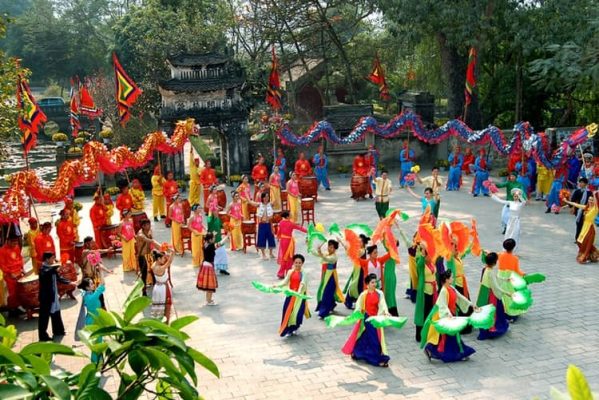
Hoa Lu Festival takes place in the ancient capital of Hoa Lu.
Time: The Hoa Lu Festival takes place annually from the 6th to the 8th day of the third lunar month, coinciding with springtime in northern Vietnam. This is an ideal period for tourists to enjoy the festival while exploring the ancient capital of Hoa Lu amidst pleasant weather and vibrant natural scenery.
Location: The festival is held at the Hoa Lu Ancient Capital in Hoa Lu District, Ninh Binh Province. This location was the first imperial capital of Vietnam during the Dinh and Early Le Dynasties and is now recognized by UNESCO as part of the Trang An Scenic Landscape Complex, a World Cultural and Natural Heritage site.
Significance:
- The Hoa Lu Festival honors the great contributions of King Dinh Tien Hoang, the founder of the Dinh Dynasty, and King Le Dai Hanh, who succeeded him and continued to develop the nation. It is also a time for people to pay tribute to the generals and national heroes who defended the country during a tumultuous historical period.
- Additionally, the festival celebrates national unity and pride, serving as an opportunity to educate younger generations about Vietnam’s heroic history.
Highlight Activities:
- The festival begins with a solemn procession of palanquins from the temples dedicated to Kings Dinh and Le, passing through the old pathways of Hoa Lu Ancient Capital. The parade is led by local officials, ceremonial musicians, and participants dressed in traditional costumes.
- At the temples, sacred rituals are conducted following traditional customs, including offerings of incense, flowers, and symbolic tributes. The solemn atmosphere provides an immersive experience for visitors interested in Vietnam’s spiritual culture.
Martial Arts Performances:
- The festival features martial arts demonstrations that reenact historical battles. Visitors can witness and feel the fighting spirit of ancient warriors through unique traditional techniques.
- Local martial arts troupes often perform scenes of military training during the Dinh and Early Le Dynasties, bringing history to life vividly.
Do not miss: Hanoi to Ninh Binh in 3 Days
2. Trang An Festival
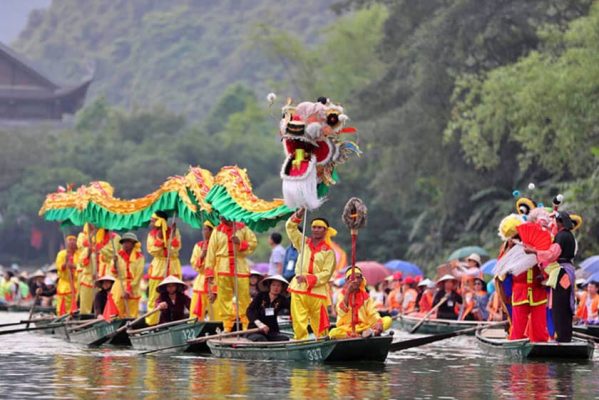
Visitors can enjoy the scenery and explore the beauty of Ninh Binh with Trang An Festival.
Time of Celebration: Held annually in March of the lunar calendar, typically lasting 2-3 days.
Location: Trang An Scenic Landscape Complex, Ninh Binh Province, a UNESCO World Cultural and Natural Heritage site.
Significance: The Trang An Festival is an occasion to honor the contributions of deities, national heroes, and ancestors who played a part in building and protecting Ninh Binh. It also serves as a prayer for peace, abundant harvests, and prosperity for both locals and visitors.
Key Activities:
Water procession, palanquin parade, and dragon procession on the river
- Water Procession: A unique highlight of the festival, reenacting a traditional ritual where locals collect sacred water from the river to offer to the deities. The ritual takes place on elaborately decorated boats, creating a sacred and visually striking scene.
- Palanquin and Dragon Parade: A procession of elders and locals in traditional attire follows dragon boats as they parade on the river. This ritual not only honors local history and culture but also provides a memorable visual experience for visitors.
Cultural performances on boats
- Gong dance: Performances featuring gongs by the Muong ethnic group evoke the vibrant spirit of the highlands.
- Cheo (traditional opera) and Xam singing: Local artists perform melodious Cheo and rustic Xam singing, traditional music forms of Northern Vietnam, right on boats gliding through the river.
Folk games along the riverbanks
- Blindfolded goat catching: A humorous and engaging game that brings tourists and locals closer together.
- Stick pushing and tug-of-war: Traditional games held on riverbank meadows attract many participants, especially international tourists eager to explore Vietnamese culture.
- Craft-making workshops: Visitors can join hands-on activities like making To He (toy figurines) or weaving, offering a deeper cultural immersion.
Read more: Things to Do in Ninh Binh.
3. Bai Dinh Pagoda Festival
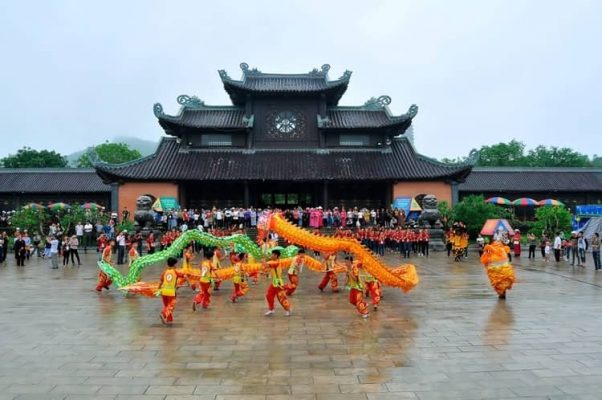
Bai Dinh Pagoda Festival represents the deep beliefs of Vietnamese people.
Time of Celebration: The Bai Dinh Pagoda Festival takes place annually from the 6th day of the first lunar month (right after the Lunar New Year) and extends until the end of the third lunar month. It is one of the largest spring festivals in northern Vietnam, providing an ideal opportunity for visitors to immerse themselves in the festive atmosphere while exploring the natural and spiritual beauty of the area.
Location: Bai Dinh Pagoda is situated on the Bai Dinh Mountain range, in Gia Sinh commune, Gia Vien district, Ninh Binh province. Renowned as the largest pagoda complex in Southeast Asia, it features grand architecture blending traditional and modern styles, attracting millions of visitors every year.
Significance: The festival is an occasion to worship Buddha, pray for prosperity, and seek blessings for the new year. It is also an opportunity for locals and tourists to pay tribute to national heroes, particularly Saint Nguyen Minh Khong, the founder of the ancient Bai Dinh Pagoda. The event highlights community connection, spiritual values, and the preservation of Vietnam’s cultural heritage.
Main Activities:
Pilgrimage at Bai Dinh Pagoda
- Participating in the opening ceremony: Held on the 6th day of the first lunar month, the opening ceremony includes traditional rituals at the Tam The Hall and the Bell Tower. Key rituals involve incense offerings, Buddhist chants, and prayers for peace and national prosperity. International visitors can observe or join these unique religious ceremonies reflecting the essence of Vietnamese Buddhism.
- Spiritual journey: The festival offers a chance to walk through the longest Arhat corridor in Asia, featuring over 500 stone Arhat statues. Highlights include prayers at the largest Buddha statue in Southeast Asia, symbolizing happiness and serenity.
Exploring Majestic Architectural Works
Bai Dinh Pagoda is famous not only for its spiritual ambiance but also for its unique architectural ensemble:
- Tam The Hall: Dedicated to three Buddhas representing the past, present, and future. Each Buddha statue is 7.2 meters tall and cast from solid bronze, evoking awe and reverence.
- The Bell Tower: Housing a great bronze bell weighing 36 tons, its resonant chime is believed to dispel worries and bring peace.
- Bronze Buddha Statue: A 10-meter-tall, 100-ton bronze statue of Buddha Shakyamuni stands as a striking centerpiece of the complex.
- Arhat Corridor: Stretching over 3 kilometers, the intricately carved corridor portrays vivid expressions of 500 Arhat statues.
You will be like: Discover Ninh Binh Day Trip from Hanoi for Best Experiences
4. Thai Vi Temple Festival
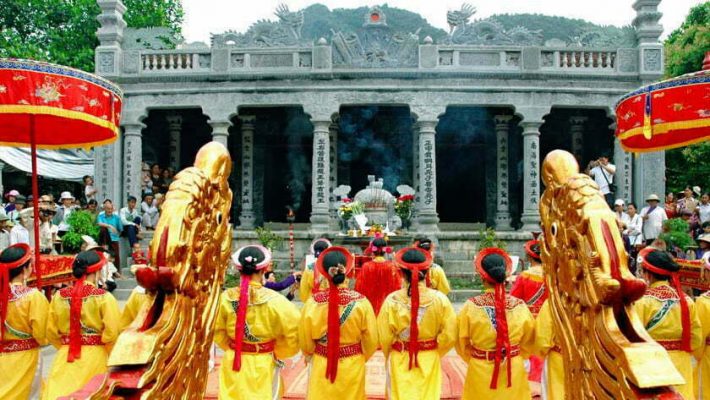
Thai Vi Temple Festival
Time: The Thai Vi Temple Festival is held annually from the 14th to the 16th of the 3rd lunar month. This is the time when local people and visitors from all over come together to organize rituals and express gratitude to the kings in Vietnam’s history, particularly King Tran Thai Tong, the first king of the Tran Dynasty.
Location: The festival takes place at Thai Vi Temple, located in Van Lam Village, Ninh Hai Commune, Hoa Lu District, Ninh Binh Province. The temple is situated near Hoa Lu, the ancient capital of Vietnam during the Dinh and Early Le Dynasties. Thai Vi Temple was built to honor the Tran Kings, especially King Tran Thai Tong, who made significant contributions to the development of the country and established many temples and pagodas in the region.
Significance:
- The Thai Vi Temple Festival is not only an occasion to remember the contributions of the Tran Kings but also an important part of the cultural and spiritual life of the people in Ninh Binh. The temple is considered a sacred place where locals and tourists come to burn incense, pray for peace, and seek good fortune.
- The festival also carries the significance of celebrating the nation’s history, particularly the Tran Dynasty, a golden era in the nation’s history when the people united to protect the country and successfully repelled the Mongol invasions.
- During the three-day festival, locals and visitors alike express their reverence for past heroes through traditional rituals, preserving and promoting the cultural and spiritual values of Hoa Lu.
Activities during the festival:
The Thai Vi Temple Festival attracts many visitors and locals, offering a variety of unique and meaningful activities. Notable events during the festival include:
Sacred Rituals
- The festival begins with solemn rituals conducted by local monks, followers, and officials. This is an opportunity to express gratitude to the Tran Kings and ancestors who contributed greatly to the development of the country.
- These rituals are held at the temple in a sacred atmosphere, allowing visitors to feel the spiritual significance of the Hoa Lu historical site.
Procession and Folk Games
- One of the key activities of the festival is the procession, featuring participants dressed in traditional costumes, along with displays of martial arts and folk games such as tug-of-war, wrestling, and con throwing. These activities not only attract the local population but also captivate international visitors, especially those interested in exploring and experiencing traditional Vietnamese culture.
Releasing Flower Lanterns
- Releasing flower lanterns on the river is a must-see event at the Thai Vi Temple Festival. The sight of illuminated lanterns floating on the water creates a mesmerizing and romantic atmosphere. Visitors join in by releasing their own lanterns to pray for peace, prosperity, and the well-being of the nation.
Exhibition and Display of Traditional Handicrafts:
- During the festival, locals often display and showcase traditional handicrafts such as conical hats, pottery, and local specialty foods from Ninh Binh. Visitors can explore the exhibits and purchase souvenirs while also learning about the region’s traditional craftsmanship.
Visiting Historical Sites
- The Thai Vi Temple Festival is also a great opportunity for visitors to explore historical landmarks in the Hoa Lu area, such as Dau Temple, Bai Dinh Pagoda, Dinh Tien Hoang Temple, and Tam Coc – Bich Dong. Combining participation in the festival with visits to these historic sites helps visitors gain a deeper understanding of the history and culture of Ninh Binh.
III. Suggested Itinerary
Ninh Binh is an ideal destination at the beginning of the year, as many traditional festivals take place simultaneously. The proximity of various attractions allows you to easily combine festival experiences with sightseeing during your trip.
Day 1: Explore Trang An and Join Its Festival
Morning:
- Begin your journey at the Trang An Ecotourism Complex, a UNESCO World Heritage Site.
- Take a boat tour to explore the magnificent cave system, surrounded by limestone karsts and lush greenery.
- Visit highlights such as Bright Cave, Dark Cave, Wine-Making Cave, and Trinh Temple.
Afternoon:
Participate in the Trang An Festival (if held). Typically taking place in the 4th lunar month, the festival includes activities such as:
- Traditional ceremonies to honor water deities.
- Lantern release, creating a magical scene on the river.
- Cultural performances and folk games.
Click here: Ninh Binh Tour in 2 Days
Day 2: Discover Hoa Lu and Join the Hoa Lu Festival
Morning:
Head to the Hoa Lu Ancient Capital, about a 10-minute drive from Trang An.
Explore the historical relics, including:
- Temple of King Dinh and Temple of King Le: Dedicated to the founders of the Dinh and Early Le dynasties.
- The remnants of ancient palaces and fortresses.
Afternoon:
Attend the Hoa Lu Festival (held in the 3rd lunar month).
Festival highlights include:
- A grand procession with traditional costumes and art troupes.
- Martial arts demonstrations and folk games like wrestling and tug-of-war.
- Cultural reenactments to honor Hoa Lu’s glorious history.
Day 3: Pilgrimage to Bai Dinh Pagoda and Local Cuisine
Morning:
Spend the morning at Bai Dinh Pagoda, one of the largest temple complexes in Southeast Asia.
Key attractions at the pagoda include:
- Tam The Hall and Phap Chu Hall: Grand halls housing massive Buddha statues.
- Bell Tower: Experience the soothing chime of the bell resonating through the complex.
- Arhat Corridor: The longest in Vietnam, lined with hundreds of intricately carved Arhat statues.
Afternoon:
- Participate in the Bai Dinh Pagoda Festival (held from the 6th day of the first lunar month through spring).
- Join Buddhist ceremonies such as peace prayers and incense offerings.
- Discover more about Vietnamese Buddhism through cultural activities and artistic performances.
In conclusion, Ninh Binh festivals are not only an opportunity for visitors to explore the unique cultural beauty of this ancient capital but also a chance to immerse themselves in the vibrant atmosphere, rich in Vietnamese traditions. From the sacred Hoa Lu Festival to the mysterious Trang An Festival and the grandeur of Bai Dinh Pagoda, each event carries a deep message about Ninh Binh’s history, beliefs, and nature.
For international tourists, these festivals offer not only a chance to learn about local culture but also a memorable experience, adding unforgettable moments to your journey through Vietnam. Visit Ninh Binh and participate in these spectacular festivals to fully appreciate the beauty of the country’s culture and nature!
See more: Ninh Binh travel tips




